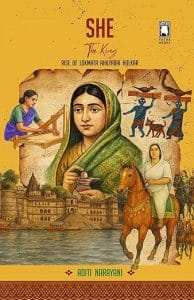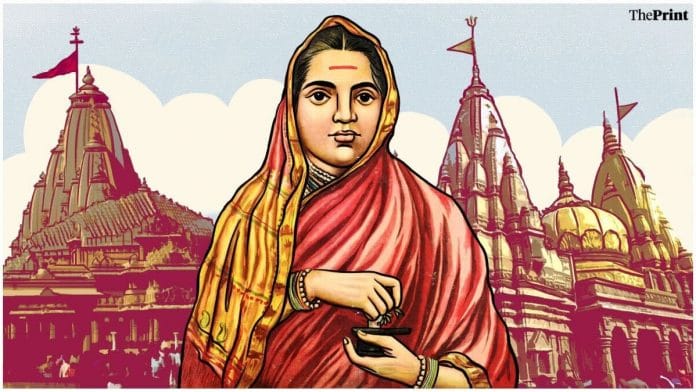Suffering in Ahilya’s personal life was immense, there were few pieces in her heart that were stuck in old griefs. Many times, a strong urge appeared in her mind to renounce everything and stay in a place of pilgrimage and pass her remaining life in the devotion of the Lord. Nevertheless, her commitment to the kingdom and pledge she had once made to her father-in-law, late Malhar Rao stymied her from renouncing everything. She had a great reverence for the sacred Narmada River, and it was not far from Indore. There were many holy places of pilgrimage along the bank of Narmada. Devi Ahilya took a brave step and decided to shift her capital to one such place of pilgrimage on the bank of Narmada, where she could run her kingdom as well as work towards her salvation.
The best location for her capital was to be the town of Kardena in the Nimar district. She abandoned the plan to establish her capital in Kardena after the astrologers informed her that the village was unsuitable for serving as the capital. After that, she noticed Maheshwar. She saw Maheshwar as the best location for both fulfilling her religious craving and building the capital. Devi Ahilya’s establishment of the capital at Maheshwar was advantageous for the area. Devi Ahilya lived in Maheshwar for roughly twenty-eight years of her life. Maheshwar emerged as a major hub at this time and gained significance on the national map. Frequent visits from rulers, ambassadors, savants, sages, and ascetics from all the nation’s major provinces and the state even experienced a complete transformation and was once again regarded as one of India’s major cities.
Renowned in ancient India as Avantika and Mahishmati, Ujjain of Malwa and Maheshwar of Nimar are the two prominent places of pilgrimage with great historical significance situated near Indore. Both these cities have great archaeological importance and find mention in the scriptures of Jain and Buddhist besides great epics like Ramayana and Mahabharata and many Puranas. Since Maheshwar was situated within the Holkar Kingdom, Devi Ahilya selected this place to build her capital. It had been a prosperous and flourishing city during the ages of Ramayana and Mahabharata. Evidence shows that Arjuna had arrived here during his mission of universal conquest. Narmada is one of India’s seven most prominent and sacred rivers.
It is the only river in the world which is circulated by thousands of devotees every year. Devi Ahilya too had strong faith and reverence for Narmada. Thus, she built her capital in Maheshwar and spent a major part of her life near the bank of Narmada. In Maheshwar, Ahilyabai got the renovation of many old temples done, which were on the verge of ruins. She also got many new temples and embankments as well as many houses built for the savants, Brahmins, and weavers. After becoming the capital of Devi Ahilya’s kingdom, its political, social as well as commercial importance of Maheshwar also grew significantly.
Devi Ahilya invited selected religious teachers, astrologers, puranic psalmists, artists, and artisans from all over the country and helped them to settle in Maheshwar. She also started many Sanskrit schools. Tradition of regular worship and other religious ceremonies in the temples also began in her time. To conduct these functions, hundreds of Brahmins and priests also settled in Maheshwar. Recitation of hymns and musical sounds of songs, conchs and other instruments reverberated all day long in the temples of Maheshwar.Devi Ahilya opened her treasure to make donations to the Brahmins and the poor and to feed them public kitchens used to be run by her aid.
Also read: It was a Tamil merchant guild that helped Rajendra Chola become a global conqueror
Devi Ahilya also got the construction of temples, embankments, inns, canopies done in almost all the places of pilgrimage in the entire country. Construction of these structures required thousands of artisans and masons. Thousands of sculptors, statuarists, artisans who were searching for employment, came to settle in Maheshwar. Efforts of Devi Ahilya led to the establishment of Maheshwar as a prominent center of cloth industry on the commercial map of the country. She invited the skilled weavers from all parts of the country and helped them to settle in Maheshwar. She helped them financially to start their business, she also bought sarees and other goods produced by those weavers to encourage them. Because of her inspiration and incentives, high quality sarees and clothes began to be produced in Maheshwar. These products had exquisite artistic work also.
Devi Ahilya herself used to wear sarees manufactured in Maheshwar and presented her guests with the clothes made in Maheshwar, as gifts. Business of the weavers began to flourish because of the liberal support, high taste and incentives of Devi Ahilya and the artisans also grew in prosperity. Ahilyabai fosters her subjects like her own children. She takes full care of their safety and comfort. She pledged to distribute free food daily through the public kitchens for the poor. From the description, it becomes clear how a small, ordinary town Maheshwar transformed into a flourishing city through her efforts. Being the capital of Holkar Kingdom, many kings sent their representatives to stay permanently in Maheshwar.
Despite the flourishing capital Devi Ahilya stayed in her simple residence and could aptly be called a hermitage. It appeared more like a place of pilgrimage, having a divinely tranquil ambience. In one of the rooms, Devi had fenced off some place for worship, where every morning she prayed and worshipped God. In the courtyard of the house, there was a small Tulsi-grove, and in front of the house was the huge embankment of Narmada. Near the house there was a small garden in which flowers and Tulsi plants had been grown for the purpose of worship. It is still maintained in the same state as it used to be at the time of Devi Ahilya.
Thousands of people from all over the world visit Maheshwar to pay their tribute to Devi Ahilya even today. When they return, they take great inspiration from her brilliant life and work with them. After watching this simple residence of Devi Ahilya and while presiding over the function of Devi Ahilya National Award ceremony in Indore, Governor of Madhya Pradesh, His Highness Dr. Bhai Mahaveer said in his speech, “People, particularly the politicians must visit Maheshwar and see the simple but extraordinary residence of Devi Ahilya. Only then, they will realize how, despite being the owner of a huge and prosperous kingdom, the pious Devi Ahilya spent her life like an expiator. Having seen her lifestyle, the modern politicians will be ashamed of their luxurious life.”
 This excerpt from Aditi Narayani’s ‘She The King: Rise of Lokmata Ahilyabai Holkar’ has been published with permission from Yatra Books – Vani Prakashan Group.
This excerpt from Aditi Narayani’s ‘She The King: Rise of Lokmata Ahilyabai Holkar’ has been published with permission from Yatra Books – Vani Prakashan Group.






